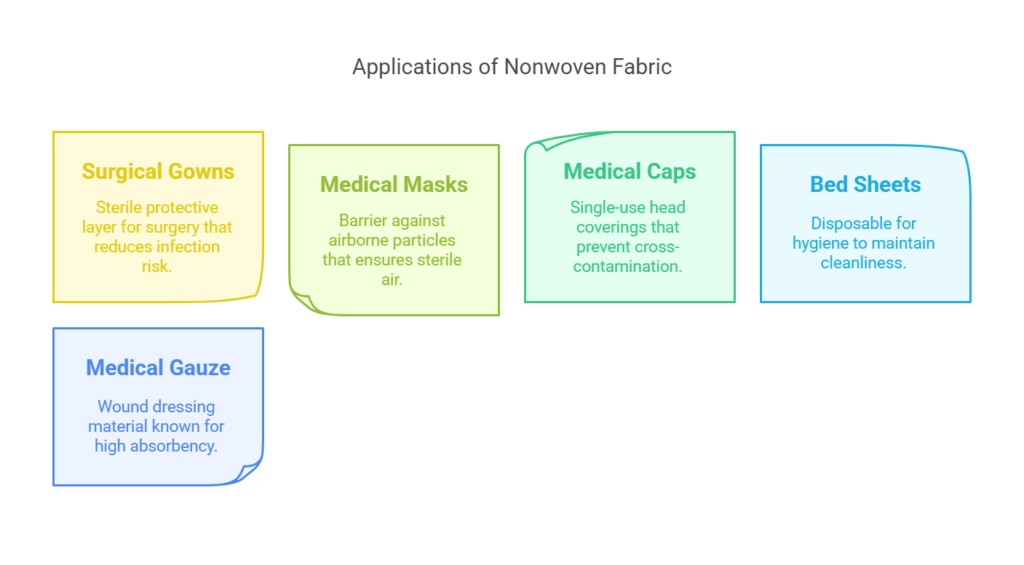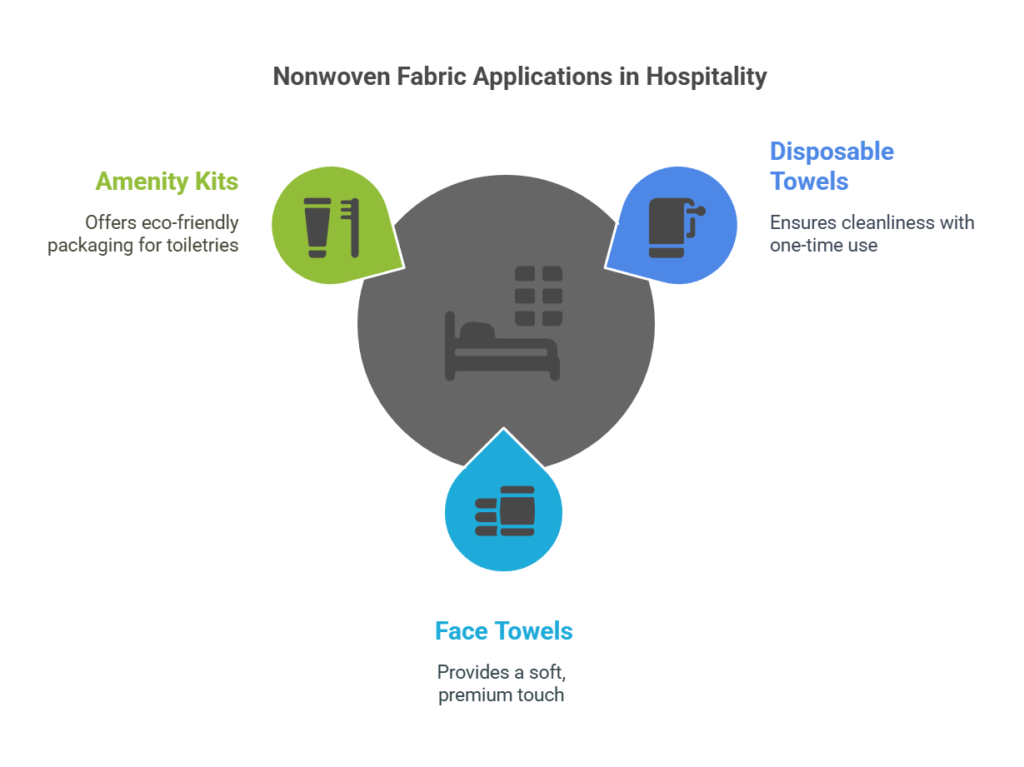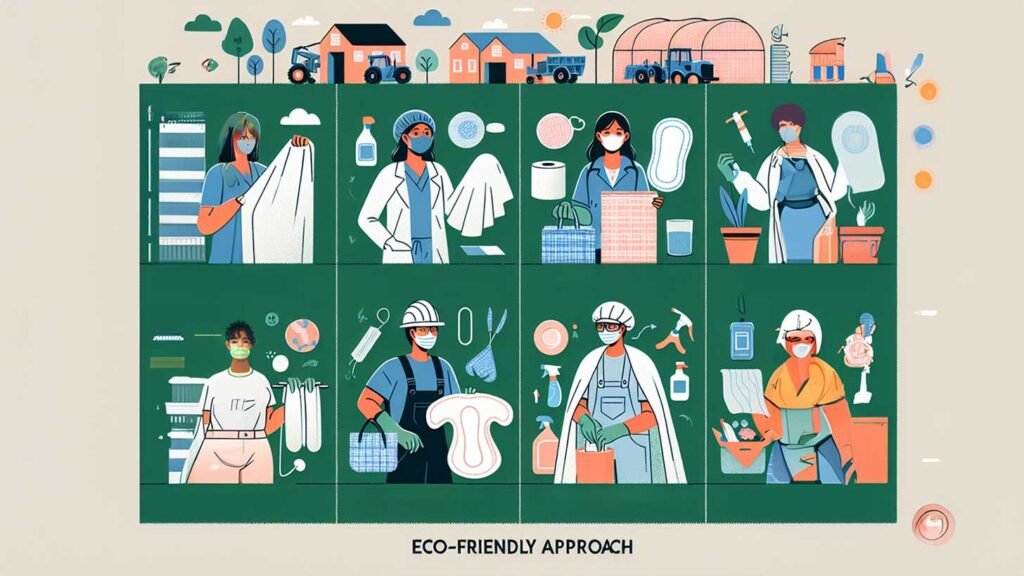Nonwoven Fabric: Cross-Domain Applications and Future Scientific Development Directions
Nonwoven fabric, at the forefront of material science, is celebrated for its innovative production techniques and remarkable versatility. It has established itself as an essential material across a spectrum of sectors, including industry, healthcare, agriculture, hospitality, and domestic life. This article will explore the application domains of nonwoven fabric, its advantages, the environmental challenges it faces, and the trajectory of future scientific development.
1. Applications in the Medical and Health Fields: Nonwoven fabric is paramount in the medical and healthcare sectors, valued for its sterile, disposable nature, and ease of handling. Its applications include:

| Application | Description | Benefits |
|---|---|---|
| Surgical Gowns | Sterile protective layer for surgery | Reduces infection risk |
| Medical Masks | Barrier against airborne particles | Ensures sterile air |
| Medical Caps | Single-use head coverings | Prevents cross-contamination |
| Bed Sheets | Disposable for hygiene | Maintains cleanliness |
| Medical Gauze | Wound dressing material | High absorbency |
- Surgical Gowns and Medical Masks: These serve as a critical barrier to protect healthcare workers from infections, with nonwoven materials providing reliable filtration and fluid resistance.
- Medical Caps and Bed Sheets: Designed for single-use to prevent cross-contamination, these items are crucial for maintaining a sterile hospital environment.
- Medical Gauze: Used in wound dressings, nonwoven gauze is preferred for its ability to absorb wound exudate efficiently while allowing for breathability.
2. Applications in Personal Care Products: The application of nonwoven fabric in personal care is a reflection of material science precision:

| Application | Description | Benefits |
|---|---|---|
| Sanitary Pads | High absorbency for menstrual care | Comfort and hygiene |
| Diapers | Absorbent and breathable | Prevents leaks |
| Cosmetic Cotton | Soft material for makeup application | Gentle on skin |
| Wet Wipes | Portable cleaning solution | Convenient and hygienic |
- Sanitary Pads and Diapers: Nonwoven fabrics in these products are engineered for high absorbency and comfort, with specialized layers to wick away moisture and prevent leaks.
- Cosmetic Cotton: Soft, non-abrasive nonwoven pads are ideal for applying toners, serums, and removing makeup without irritating the skin.
- Wet Wipes: These portable sheets are used for a variety of purposes, from baby wipes with gentle formulas to adult wipes for personal hygiene and makeup removal.
3. Applications in Agricultural Technology: Nonwoven fabric’s applications in agriculture illustrate a harmonious blend of science and nature:

| Application | Description | Benefits |
|---|---|---|
| Crop Protection | Covers to protect from weather and pests | Enhances crop yield |
| Insulation Materials | Provides thermal protection to crops | Supports off-season growth |
| Weed Control Cloth | Suppresses weed growth | Reduces use of herbicides |
- Crop Protection Cloth: Used in row covers and hoop houses, nonwoven fabrics protect crops from frost, hail, and insects without impeding photosynthesis.
- Insulation Materials: Nonwoven materials provide thermal insulation for seedlings and delicate plants, ensuring even growth and development.
- Weed Control Cloth: By preventing weed growth, nonwoven fabrics reduce the need for chemical herbicides, promoting a more sustainable approach to agriculture.
4. Applications in Industrial Materials: The durability and functionality of nonwoven fabric are widely recognized in the industrial sector:

| Application | Description | Benefits |
|---|---|---|
| Filtering Materials | For air and liquid filtration systems | High filtration efficiency |
| Insulating Materials | In electronics and electrical panels | Enhances safety and performance |
| Reinforcement Materials | In plastics, rubber, and automotive parts | Adds strength and durability |
- Filtering Materials: Nonwoven fabrics are used in a range of filters from personal respirators to large-scale industrial air filters and water purification systems.
- Insulating Materials: In the construction of electronic devices and electrical panels, nonwoven insulating materials offer thermal insulation and reduce the risk of electrical shorts.
- Reinforcement Materials: Nonwoven fabrics are used in the production of reinforced plastics, rubber, and even in automotive parts for added strength and durability.
5. Applications in Household Products: The convenience and cost-effectiveness of nonwoven fabric are evident in household items:

| Application | Description | Benefits |
|---|---|---|
| Disposable Tablecloths | Easy to clean and dispose of | Convenience for events |
| Cleaning Cloths | Highly absorbent and durable | Versatile cleaning uses |
| Shopping Bags | Reusable and foldable | Environmentally friendly |
- Disposable Tablecloths: Especially useful for events, these tablecloths are easily disposed of or recycled after use, providing a hygienic and easy solution for large gatherings.
- Cleaning Cloths: Nonwoven cleaning cloths are available in various materials, from basic spunbond to more sophisticated materials with antimicrobial properties for effective cleaning.
- Shopping Bags: Durable and reusable, nonwoven bags are a popular choice for grocery shopping, featuring reinforced handles to bear heavy loads.
6. Applications in the Spa Industry: Nonwoven fabric is also gaining popularity in the spa and wellness industry for its softness, cleanliness, and disposable options:

| Application | Description | Benefits |
|---|---|---|
| Sheets | Disposable for hygiene | Ensures cleanliness |
| Head and Foot Covers | Protects hair and feet during treatments | Provides comfort |
| Spa Clothing | Soft, comfortable robes and garments | Easy maintenance |
- Sheets: Nonwoven sheets offer a convenient and hygienic option for spa beds, ensuring a fresh and clean surface for each client.
- Head and Foot Covers: Used to keep clients’ hair and feet clean during treatments, nonwoven covers provide a comfortable and sterile experience.
- Spa Clothing: Nonwoven robes and garments are sometimes used in spas for their soft texture and ease of maintenance.
7. Applications in the Hospitality Industry: Nonwoven fabric has found a niche in the hospitality industry, particularly in hotels, for its convenience and hygiene.

| Application | Description | Benefits |
|---|---|---|
| Disposable Towels | One-time use for guests | Ensures guest hygiene |
| Face Towels | Soft and gentle for facial use | Provides a premium touch |
| Amenity Kits | Packaging for toiletries and amenities | Eco-friendly packaging |
- Disposable Towels: Nonwoven fabric is used to make disposable towels, including bath towels and hand towels, which are provided to guests for a one-time use, ensuring cleanliness.
- Face Towels: Soft and gentle on the skin, disposable face towels are often offered in hotel rooms for guests’ convenience.
- Hotel Amenity Kits: Nonwoven bags are used to package and provide toiletries and other amenities, offering an eco-friendly alternative to plastic packaging.
8. Environmental Challenges and Scientific Solutions: The environmental impact of nonwoven fabric is a growing concern, prompting the scientific and industrial communities to explore solutions:

| Challenge | Scientific Solution | Aim |
|---|---|---|
| Biodegradability | Research into bio-based materials | To create fabrics that degrade naturally |
| Recycling | Innovations in recycling technology | To reduce waste and promote a circular economy |
- Developing Biodegradable Materials: Research is being conducted into bio-based materials such as polylactic acid (PLA) to create nonwoven fabrics that degrade more rapidly in the environment.
- Improving Recycling Rates: Innovations in recycling technology aim to make the process more efficient and cost-effective, thereby reducing the environmental footprint of nonwoven fabric waste.
Conclusion: The broad application of nonwoven fabric underscores the importance of material science in modern society. With technological advancements and increased environmental awareness, the nonwoven fabric industry is evolving towards sustainability and eco-friendliness. Future developments will likely focus on innovative technologies and sustainable materials to achieve greener, more efficient production processes.
Call to Action from the Scientific Community: We, as members of the scientific community, encourage consumers to opt for environmentally friendly nonwoven fabric products, participate in recycling programs, and educate themselves on the environmental impact of nonwoven fabrics. We also urge businesses and research institutions to continue exploring sustainable production methods and materials, driving the nonwoven fabric industry towards green development and contributing to global sustainability goals.
Conclusion:
FAQs:
- Q: What are the key advantages of nonwoven fabrics in the medical field? A: Nonwoven fabrics offer sterility, single-use convenience, and high absorbency, which are crucial for minimizing hospital-acquired infections and maintaining hygiene standards in medical settings.
- Q: How do nonwoven fabrics enhance personal care products? A: They provide superior softness, high absorbency, and breathability, enhancing user comfort and ensuring better personal hygiene.
- Q: What role do nonwoven fabrics play in agricultural applications? A: They serve as crop protection covers, insulation materials, and weed control fabrics, which protect crops and contribute to sustainable agricultural practices by reducing the need for chemical herbicides.
- Q: How do nonwoven fabrics contribute to industrial applications? A: They are used in filtration systems for air and liquids, as insulating materials in electronics and electrical applications, and as reinforcement materials in construction, showcasing their durability and functional versatility.
- Q: What are the benefits of nonwoven fabrics in household products? A: Nonwoven fabrics offer convenience, cost-effectiveness, and ease of maintenance, making them ideal for disposable tablecloths, cleaning cloths, and reusable shopping bags.
- Q: What are the unique advantages of nonwoven fabrics in filtration systems? A: They provide high efficiency in trapping particles due to their fine fiber structure, are cost-effective to produce, and can be tailored to filter specific particle sizes in various applications, from medical masks to industrial filters.
- Q: How do nonwoven fabrics improve the efficiency of cleaning products? A: Their high absorbency allows for better cleaning performance with less liquid, and their durability means they can be used multiple times, which is both economical and environmentally friendly.
- Q: What are the benefits of nonwoven fabrics for insulation in construction? A: Nonwoven fabrics offer lightweight, breathable insulation that helps maintain indoor air quality and thermal comfort while reducing energy consumption.
- Q: Are there any innovations in nonwoven fabrics that enhance their performance? A: Innovations such as the incorporation of antimicrobial agents, development of smart textiles with embedded sensors, and the use of nanofibers for higher filtration efficiency are expanding the capabilities of nonwoven fabrics.


4 Responses
Can you be more specific about the content of your article? After reading it, I still have some doubts. Hope you can help me.
Thank you for your comment and feedback. We truly appreciate that you took the time to read our article. We’d be more than happy to clarify any doubts you have. Please let us know which specific parts of the article you’re confused about, and we’ll do our best to provide more detailed and specific information.
Looking forward to hearing from you.
Your article helped me a lot, is there any more related content? Thanks!
We’re delighted to hear that our article was helpful to you! There’s indeed more related content on our website. You can explore the ‘Industry Insights’ and ‘Product Knowledge’ sections, where you’ll find in – depth articles, case studies, and the latest trends in the non – woven field. If you have any specific topics you’d like us to cover, feel free to let us know.